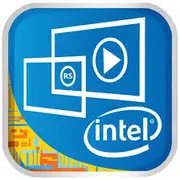Intel Core M-5Y51

Intel Core M-5Y51: Energy-Efficient Processor for Ultraportable Devices
April 2025
Introduction
The Intel Core M-5Y51 processor, released in 2015, marked an important step in the evolution of mobile chips. Despite its age, it is still found in used and budget ultrabooks. In this article, we will explore its relevance in 2025, what tasks it can handle, and who should pay attention to devices with this CPU.
Architecture and Process Technology
14 nm and Broadwell Microarchitecture
The Core M-5Y51 is based on the Broadwell microarchitecture (5th generation Intel Core) and is built on a 14 nm manufacturing process. This has helped reduce power consumption and improve thermal performance.
- 2 cores / 4 threads: Hyper-Threading enables parallel processing of lightweight tasks.
- Base frequency: 1.1 GHz, Turbo Boost up to 2.6 GHz (temporary boost for peak loads).
- L3 cache: 4 MB — ample for office applications and web browsing.
- Integrated graphics: Intel HD Graphics 5300 (24 EU, frequency up to 900 MHz).
Architecture Features:
- Passive cooling: With a TDP of 4.5 W, many devices operate without fans.
- Support for AVX2 instructions: Accelerates media tasks (such as video encoding).
Power Consumption and TDP
4.5 W — A Record for Its Time
The key feature of the Core M-5Y51 is its TDP (Thermal Design Power) of 4.5 W, which enabled the creation of ultra-slim laptops and hybrid devices.
- Energy efficiency: Intel Smart Cache and Dynamic Power Coordination technologies optimize load on the cores.
- Operating modes: In idle state, frequency reduces to 300 MHz, extending battery life.
Comparison with Contemporaries:
- Intel Core i5-5200U (15 W TDP) — 30% more powerful but requires active cooling.
- Apple A8X (2014) — similar TDP but higher performance in single-threaded tasks.
Performance in Real Tasks
Office and Multimedia
- Office applications (Word, Excel): Smooth performance even with large spreadsheets.
- Web browsing: 10-15 tabs in Chrome with 8 GB of RAM — some stuttering might occur.
- Video 1080p/4K: Smooth playback through VLC or YouTube (with hardware acceleration).
Gaming
- Light games: Minecraft (30-40 FPS on low settings), Stardew Valley, Hearthstone.
- Modern titles: Not intended for AAA games even on minimum settings.
Turbo Boost: Short-term Burst
Under load on 1-2 cores, the frequency can rise to 2.6 GHz, but it drops after 20-30 seconds due to overheating. For instance, when running Photoshop, the processor may “boost,” but will revert to base frequency during filter rendering.
Usage Scenarios
Who Should Consider the Core M-5Y51 in 2025?
1. Students: For text work, presentations, and online courses.
2. Travelers: Devices weighing up to 1 kg (for example, Lenovo Yoga 3 Pro) with 7-9 hours of battery life.
3. Secondary device: As a supplement to a powerful PC for trips.
Who Should Avoid It:
- Video editors, gamers, engineers (require at least 4 cores and dedicated graphics).
Battery Life
How TDP 4.5 W Affects Battery
With a battery capacity of 40 Wh, the operational time can reach 8-10 hours in reading/video playback mode.
- Power-saving technologies:
- Intel SpeedStep: Dynamic frequency adjustment.
- C-states: Disabling unused components.
- Tips: Disable Turbo Boost in OS settings to extend battery life by 15-20%.
Comparison with Competitors
AMD, Apple, and Previous Generations of Intel
- AMD A6-8500P (15 W TDP): Better graphics (Radeon R5) but higher power consumption.
- Apple M1 (2020): 3-4 times faster in multi-threaded tasks with similar TDP.
- Intel Core i3-10110U (10th Gen): 50% higher performance but requires active cooling.
Conclusion: The Core M-5Y51 falls short against modern chips but wins on price (devices available from $150 on the used market).
Pros and Cons
Strengths:
- Passive cooling (quiet operation).
- Compact devices (thickness from 12 mm).
- Sufficient performance for basic tasks.
Weaknesses:
- Low multi-thread performance.
- Outdated graphics (HD 5300 does not support DirectX 12 Ultimate).
- Limited upgrade potential (RAM and SSD are often soldered).
Recommendations for Laptop Selection
Types of Devices
- Ultrabooks: Dell XPS 13 (2015), HP Spectre x360.
- Convertible tablets: Microsoft Surface Pro 4.
What to Look For:
1. RAM: Minimum 8 GB (4 GB in 2025 will be painful).
2. Storage: Only SSD (preferably NVMe).
3. Screen: Full HD (no less) for comfortable work.
4. Ports: USB-C/Thunderbolt for peripheral connections.
Prices: New devices with Core M-5Y51 are no longer produced, but used models cost between $150-300.
Final Conclusion
The Intel Core M-5Y51 is a specialized processor for ultraportable tasks. In 2025, it is suitable for:
- Budget users who need a lightweight laptop for internet and office tasks.
- Those who value silence and battery life.
Key Advantages:
- Low price on the used market.
- Ability to work all day without recharging.
Alternatives for 2025:
- New laptops with Intel Core i3-N305 (7 W TDP, starting at $400).
- ARM tablets (for example, Surface Pro X with SQ3).
If you are not willing to cope with limitations, it’s better to pay more for a modern processor. But for undemanding tasks, the Core M-5Y51 remains a practical choice.
Basic
CPU Specifications
Memory Specifications
GPU Specifications
Miscellaneous
Benchmarks
Compared to Other CPU
Share in social media
Or Link To Us
<a href="https://cputronic.com/cpu/intel-core-m-5y51" target="_blank">Intel Core M-5Y51</a>